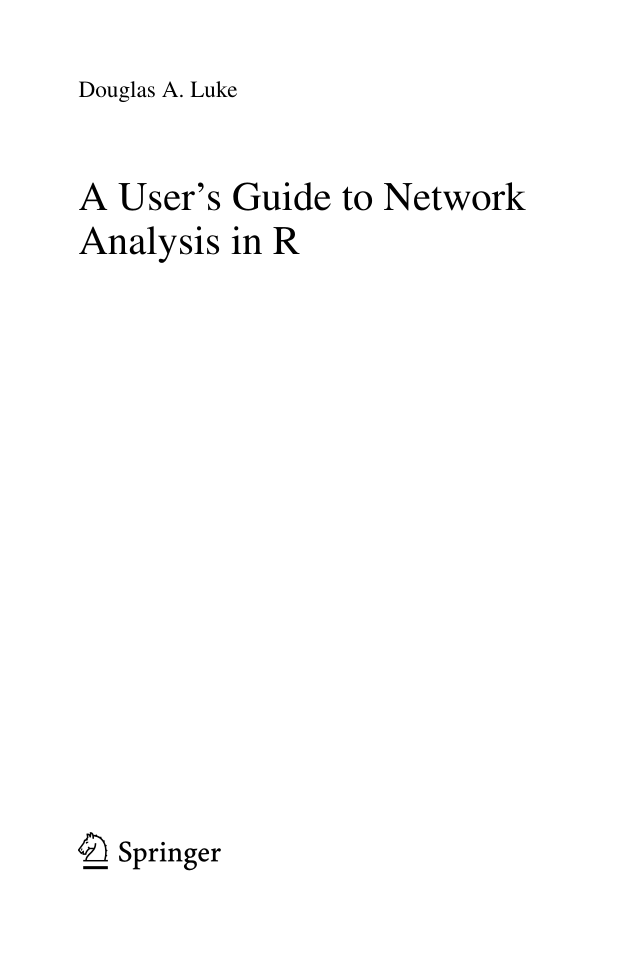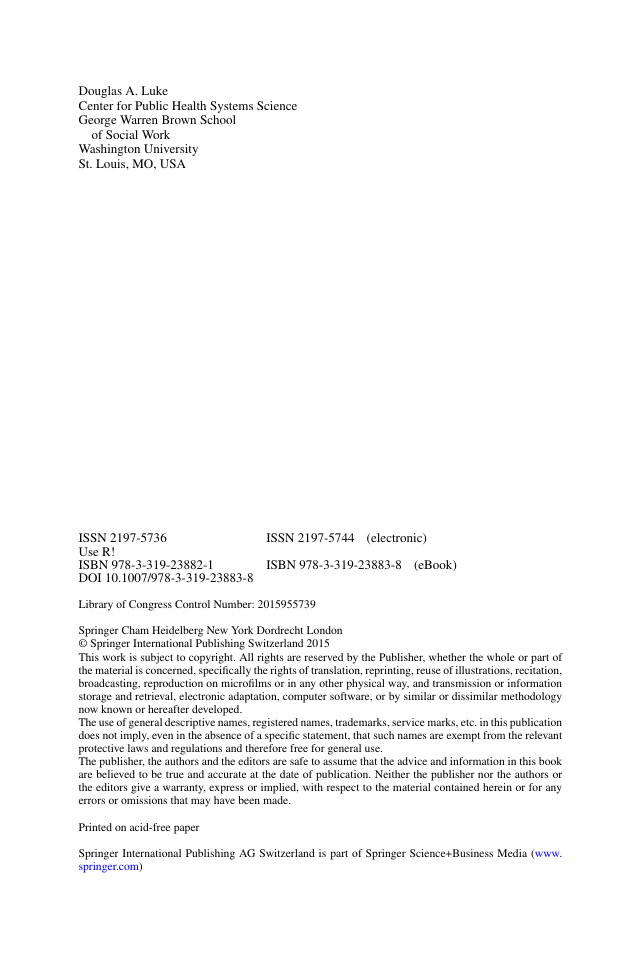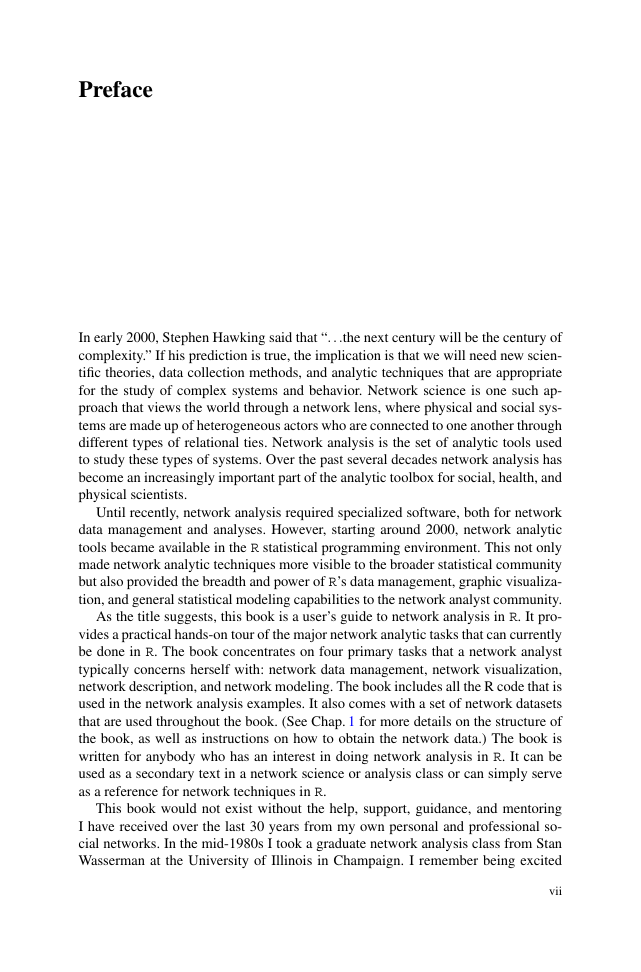Preface
Contents
1 Introducing Network Analysis in R
1.1 What Are Networks?
1.2 What Is Network Analysis?
1.3 Five Good Reasons to Do Network Analysis in R
1.3.1 Scope of R
1.3.2 Free and Open Nature of R
1.3.3 Data and Project Management Capabilities of R
1.3.4 Breadth of Network Packages in R
1.3.5 Strength of Network Modeling in R
1.4 Scope of Book and Resources
1.4.1 Scope
1.4.2 Book Roadmap
1.4.3 Resources
Part I Network Analysis Fundamentals
2 The Network Analysis `Five-Number Summary'
2.1 Network Analysis in R: Where to Start
2.2 Preparation
2.3 Simple Visualization
2.4 Basic Description
2.4.1 Size
2.4.2 Density
2.4.3 Components
2.4.4 Diameter
2.5 Clustering Coefficient
3 Network Data Management in R
3.1 Network Data Concepts
3.1.1 Network Data Structures
3.1.1.1 Sociomatrices
3.1.1.2 Edge-Lists
3.1.2 Information Stored in Network Objects
3.2 Creating and Managing Network Objects in R
3.2.1 Creating a Network Object in statnet
3.2.2 Managing Node and Tie Attributes
3.2.2.1 Node Attributes
3.2.2.2 Tie Attributes
3.2.3 Creating a Network Object in igraph
3.2.4 Going Back and Forth Between statnet and igraph
3.3 Importing Network Data
3.4 Common Network Data Tasks
3.4.1 Filtering Networks Based on Vertex or Edge AttributeValues
3.4.1.1 Filtering Based on Node Values
3.4.1.2 Removing Isolates
3.4.1.3 Filtering Based on Edge Values
3.4.2 Transforming a Directed Network to a Non-directedNetwork
Part II Visualization
4 Basic Network Plotting and Layout
4.1 The Challenge of Network Visualization
4.2 The Aesthetics of Network Layouts
4.3 Basic Plotting Algorithms and Methods
4.3.1 Finer Control Over Network Layout
4.3.2 Network Graph Layouts Using igraph
5 Effective Network Graphic Design
5.1 Basic Principles
5.2 Design Elements
5.2.1 Node Color
5.2.2 Node Shape
5.2.3 Node Size
5.2.4 Node Label
5.2.5 Edge Width
5.2.6 Edge Color
5.2.7 Edge Type
5.2.8 Legends
6 Advanced Network Graphics
6.1 Interactive Network Graphics
6.1.1 Simple Interactive Networks in igraph
6.1.2 Publishing Web-Based Interactive Network Diagrams
6.1.3 Statnet Web: Interactive statnet with shiny
6.2 Specialized Network Diagrams
6.2.1 Arc Diagrams
6.2.2 Chord Diagrams
6.2.3 Heatmaps for Network Data
6.3 Creating Network Diagrams with Other R Packages
6.3.1 Network Diagrams with ggplot2
Part III Description and Analysis
7 Actor Prominence
7.1 Introduction
7.2 Centrality: Prominence for Undirected Networks
7.2.1 Three Common Measures of Centrality
7.2.1.1 Degree Centrality
7.2.1.2 Closeness Centrality
7.2.1.3 Betweenness Centrality
7.2.2 Centrality Measures in R
7.2.3 Centralization: Network Level Indices of Centrality
7.2.4 Reporting Centrality
7.3 Cutpoints and Bridges
8 Subgroups
8.1 Introduction
8.2 Social Cohesion
8.2.1 Cliques
8.2.2 k-Cores
8.3 Community Detection
8.3.1 Modularity
8.3.2 Community Detection Algorithms
9 Affiliation Networks
9.1 Defining Affiliation Networks
9.1.1 Affiliations as 2-Mode Networks
9.1.2 Bipartite Graphs
9.2 Affiliation Network Basics
9.2.1 Creating Affiliation Networks from Incidence Matrices
9.2.2 Creating Affiliation Networks from Edge Lists
9.2.3 Plotting Affiliation Networks
9.2.4 Projections
9.3 Example: Hollywood Actors as an Affiliation Network
9.3.1 Analysis of Entire Hollywood Affiliation Network
9.3.2 Analysis of the Actor and Movie Projections
Part IV Modeling
10 Random Network Models
10.1 The Role of Network Models
10.2 Models of Network Structure and Formation
10.2.1 Erdős-Rényi Random Graph Model
10.2.2 Small-World Model
10.2.3 Scale-Free Models
10.3 Comparing Random Models to Empirical Networks
11 Statistical Network Models
11.1 Introduction
11.2 Building Exponential Random Graph Models
11.2.1 Building a Null Model
11.2.2 Including Node Attributes
11.2.3 Including Dyadic Predictors
11.2.4 Including Relational Terms (Network Predictors)
11.2.5 Including Local Structural Predictors (Dyad Dependency)
11.3 Examining Exponential Random Graph Models
11.3.1 Model Interpretation
11.3.2 Model Fit
11.3.3 Model Diagnostics
11.3.4 Simulating Networks Based on Fit Model
12 Dynamic Network Models
12.1 Introduction
12.1.1 Dynamic Networks
12.1.2 RSiena
12.2 Data Preparation
12.3 Model Specification and Estimation
12.3.1 Specification of Model Effects
12.3.2 Model Estimation
12.4 Model Exploration
12.4.1 Model Interpretation
12.4.2 Goodness-of-Fit
12.4.3 Model Simulations
13 Simulations
13.1 Simulations of Network Dynamics
13.1.1 Simulating Social Selection
13.1.1.1 Setting Up the Simulation
13.1.1.2 Creating an Update Function
13.1.1.3 Building a Simple Simulation of Social Selection
13.1.1.4 Interpreting the Results of the Simulation
13.1.2 Simulating Social Influence
13.1.2.1 Setting Up the Simulation
13.1.2.2 Creating an Update Function
13.1.2.3 Building the Simulation of Social Influence
13.1.2.4 Interpreting the Results of the Simulation
References
















 2023年江西萍乡中考道德与法治真题及答案.doc
2023年江西萍乡中考道德与法治真题及答案.doc 2012年重庆南川中考生物真题及答案.doc
2012年重庆南川中考生物真题及答案.doc 2013年江西师范大学地理学综合及文艺理论基础考研真题.doc
2013年江西师范大学地理学综合及文艺理论基础考研真题.doc 2020年四川甘孜小升初语文真题及答案I卷.doc
2020年四川甘孜小升初语文真题及答案I卷.doc 2020年注册岩土工程师专业基础考试真题及答案.doc
2020年注册岩土工程师专业基础考试真题及答案.doc 2023-2024学年福建省厦门市九年级上学期数学月考试题及答案.doc
2023-2024学年福建省厦门市九年级上学期数学月考试题及答案.doc 2021-2022学年辽宁省沈阳市大东区九年级上学期语文期末试题及答案.doc
2021-2022学年辽宁省沈阳市大东区九年级上学期语文期末试题及答案.doc 2022-2023学年北京东城区初三第一学期物理期末试卷及答案.doc
2022-2023学年北京东城区初三第一学期物理期末试卷及答案.doc 2018上半年江西教师资格初中地理学科知识与教学能力真题及答案.doc
2018上半年江西教师资格初中地理学科知识与教学能力真题及答案.doc 2012年河北国家公务员申论考试真题及答案-省级.doc
2012年河北国家公务员申论考试真题及答案-省级.doc 2020-2021学年江苏省扬州市江都区邵樊片九年级上学期数学第一次质量检测试题及答案.doc
2020-2021学年江苏省扬州市江都区邵樊片九年级上学期数学第一次质量检测试题及答案.doc 2022下半年黑龙江教师资格证中学综合素质真题及答案.doc
2022下半年黑龙江教师资格证中学综合素质真题及答案.doc